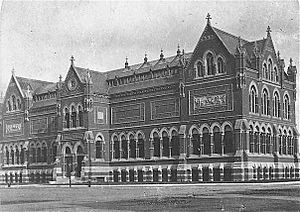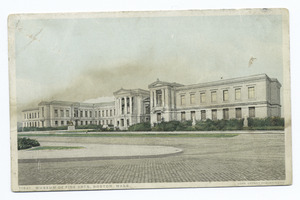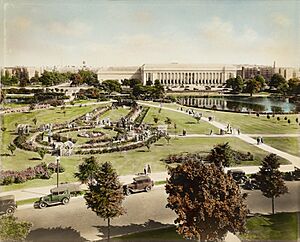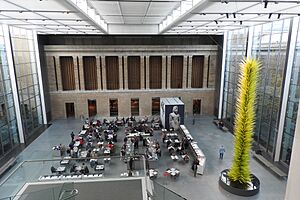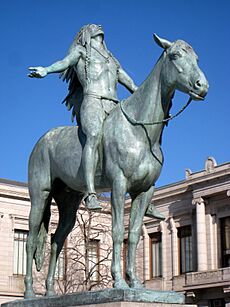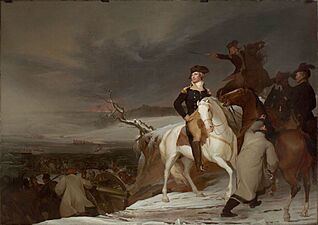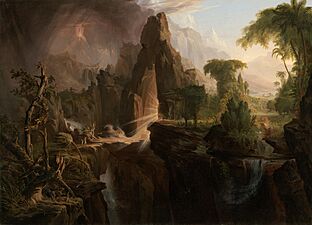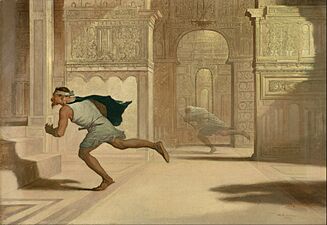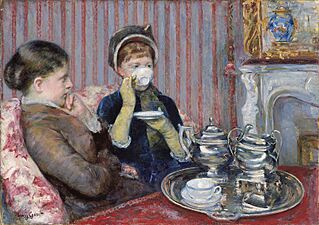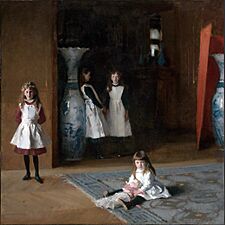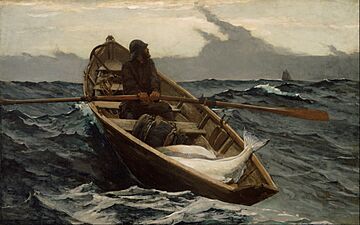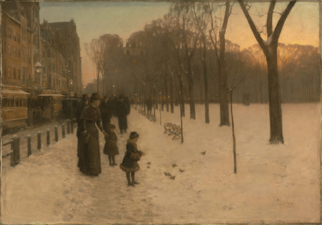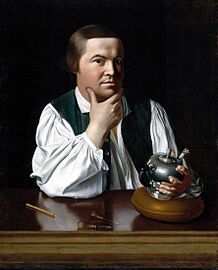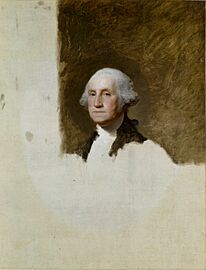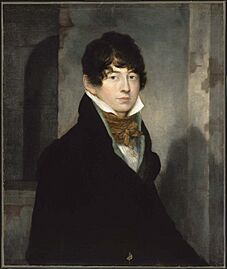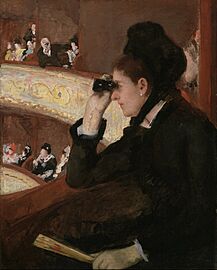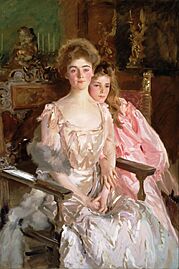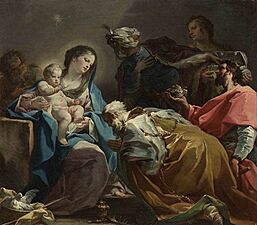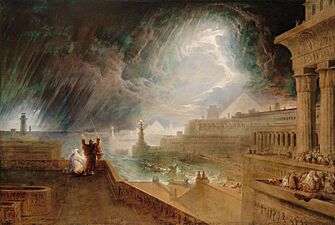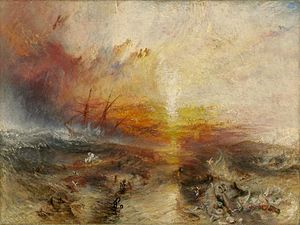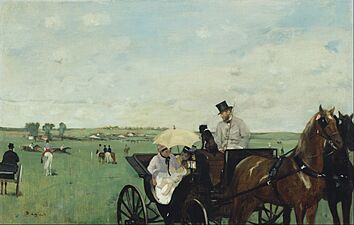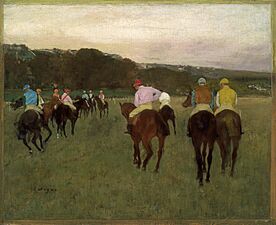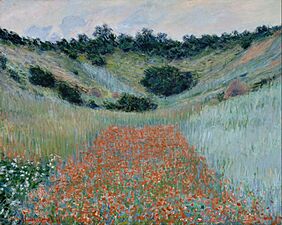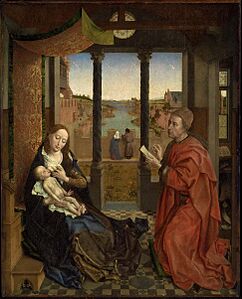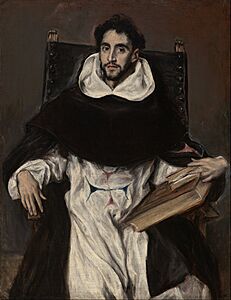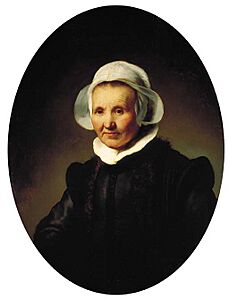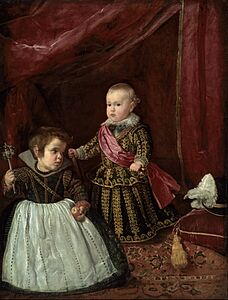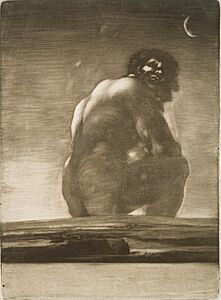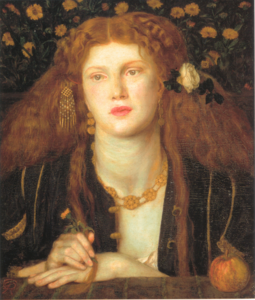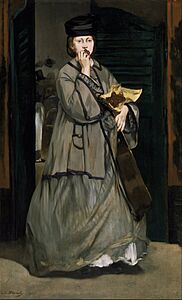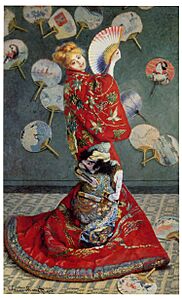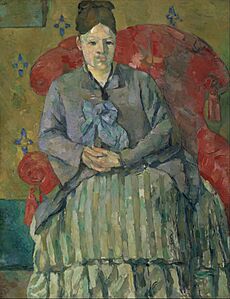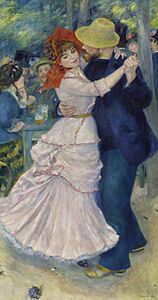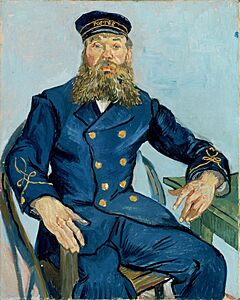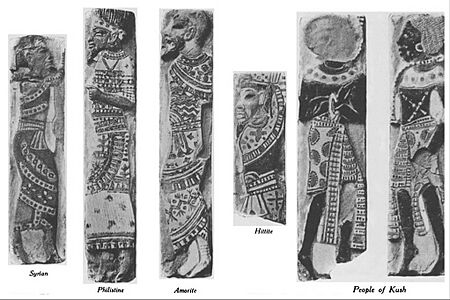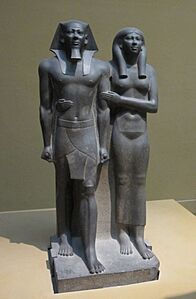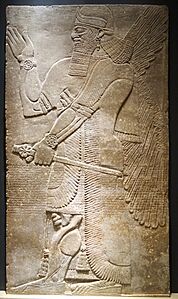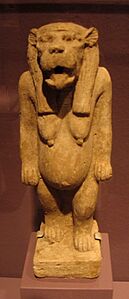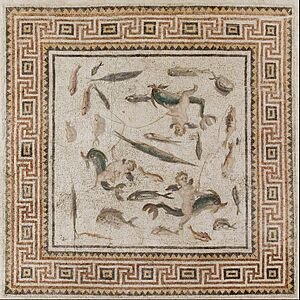Museum of Fine Arts, Boston facts for kids
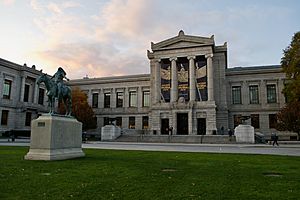
Museum of Fine Arts main entrance with the Appeal to the Great Spirit statue in the foreground
|
|
| Lua error in Module:Location_map at line 420: attempt to index field 'wikibase' (a nil value). | |
| Established | 1870 |
|---|---|
| Location | 465 Huntington Avenue Boston, Massachusetts 02115 |
| Type | Art museum |
| Accreditation | AAM |
| Visitors | 1,249,080 (2019) |
| Architect | Guy Lowell |
| Public transit access |
Green Line (E branch)
Museum of Fine Arts Orange Line
Ruggles Franklin Line
Ruggles Providence/Stoughton Line
Ruggles |
The Museum of Fine Arts (often called MFA Boston or MFA) is a huge art museum in Boston, Massachusetts. It's one of the biggest art museums in the world, with lots of space to show off amazing artworks. The museum holds over 8,000 paintings and more than 450,000 other art pieces. This makes it one of the most complete art collections in North and South America. Over a million people visit the MFA each year to see its treasures.
The museum first opened in 1870 in Copley Square. Later, in 1909, it moved to its current spot in the Fenway area. The MFA is also connected to the School of the Museum of Fine Arts at Tufts, where students can study art.
Contents
Museum History: A Journey Through Time
Early Days: 1870–1907
The Museum of Fine Arts started in 1870. Its first home was on the top floor of the Boston Athenæum, a library and cultural center. Many of its first artworks came from the Athenæum's own art collection. In 1876, the museum moved into a fancy new building in Copley Square. This building was made of brick and terracotta, a type of baked clay.
After the MFA moved to its new location in 1909, this old building was taken down. A hotel, the Fairmont Copley Plaza, was built there instead. During these early years, Charles Greely Loring, a former general, was the museum's first director. He led the museum from 1876 until 1902.
Growing Bigger: 1907–1999
In 1907, plans were made for a brand new museum building on Huntington Avenue. This new spot was in Boston's Fenway–Kenmore neighborhood. It was also close to the Isabella Stewart Gardner Museum, which had just opened. The museum hired architect Guy Lowell to design a building that could be built in parts as money became available.
Two years later, in 1909, the first part of Lowell's design was finished. It had a long granite front and a grand round hall called a rotunda. The museum officially moved into its new home that year.
More parts were added over time. A wing for paintings opened in 1915. Famous artist John Singer Sargent painted beautiful pictures on the walls of the rotunda between 1916 and 1925. These paintings show Greek gods and heroes.
Other additions included the Decorative Arts Wing in 1928 and the West Wing in 1981. The West Wing, now called the Linde Family Wing for Contemporary Art, has the museum's cafe, restaurant, and spaces for exhibitions and classes. A Japanese garden called Tenshin-En opened in 1988.
Modern Times: 2000–Present
In the early 2000s, the museum started a big project to update and expand its buildings. They raised a lot of money to build a new wing and improve the museum.
During a tough economic time, the museum found ways to earn money. They sent some of their art to other places for special shows. In 2011, the museum sold some paintings by famous artists like Monet to buy a painting by Gustave Caillebotte called Man at His Bath.
A major renovation included the new Art of the Americas Wing. This wing shows art from North, South, and Central America. It opened on November 20, 2010, and over 13,500 people visited on the first day. The new wing has a huge glass-covered courtyard with a tall glass sculpture called Lime Green Icicle Tower by Dale Chihuly.
In 2015, the museum updated its outdoor Japanese garden, Tenshin-en. This garden was first opened in 1988 and designed by Japanese professor Kinsaku Nakane.
The museum closed for a while in 2020 because of the COVID-19 pandemic. To help bring visitors back, the museum launched a new look and outreach programs in 2022. These efforts included showing official portraits of former US President Barack Obama and Michelle Obama.
Amazing Art Collections
The Museum of Fine Arts has art from many different times and places. You can explore a huge online database with information and pictures of over 346,000 items from its collection. This makes it easy to learn about the art from anywhere!
Some of the cool things you can see include:
- Ancient Egyptian Treasures: Sculptures, sarcophagi (fancy coffins), and jewelry from as far back as 6500 BCE. Many of these were found during excavations in Egypt and Sudan.
- Nubian Art: Pottery, huge royal statues, and jewelry from the ancient Nubian kingdom.
- Dutch Golden Age Paintings: Many artworks from the 1600s, including a large gift of 113 paintings from collectors in 2017.
- French Impressionist Art: Famous paintings by artists like Claude Monet, Pierre-Auguste Renoir, Edgar Degas, and Vincent van Gogh.
- American Art: Works from the 1700s and 1800s by artists such as John Singleton Copley and John Singer Sargent.
- Native American Art: A collection of works from different Native American cultures.
- Chinese Art: Imperial ceramics, ancient bronzes, large Buddhist sculptures, and paintings from many periods of Chinese history.
- Japanese Art: The biggest collection of Japanese artworks outside of Japan itself.
- Modern Art: The Linde Family Wing for Contemporary Art features works by artists like Andy Warhol.
- Musical Instruments: Over 1,100 historical musical instruments, with some on display. You might even catch a live demonstration!
Japanese Art: A World Outside Japan
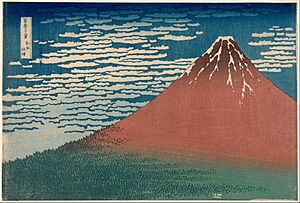
The Museum of Fine Arts has the largest collection of Japanese art anywhere in the world, except for Japan itself. It includes 4,000 Japanese paintings, 5,000 ceramic pieces, and over 30,000 ukiyo-e prints.
This amazing collection grew thanks to four men in the late 1800s: Ernest Fenollosa, Kakuzo Okakura, William Sturgis Bigelow, and Edward Sylvester Morse. They all spent time in Japan and loved Japanese art. Their gifts make up about 75% of the collection today. In 1890, the MFA was the first museum in the US to have a special collection and a curator just for Japanese art.
The collection also has many Buddhist statues. Around the early 1900s, many of these statues were sold from temples in Japan and found their way to the MFA. Today, the museum works to preserve and restore these important pieces. The museum also collects art from modern Japanese artists.
The MFA has shared its Japanese art with Japan. From 1999 to 2018, the museum exchanged artworks with its sister museum in Nagoya, Japan. In 2012, a traveling show of "Japanese Masterpieces from the Museum of Fine Arts, Boston" was very popular in Japanese cities.
In 2023, the museum held a special show called "Hokusai: Inspiration and Influence." It celebrated the famous Japanese artist Hokusai and his impact on art.
Returning Ancient Relics
In April 2024, the museum gave back several 14th-century Buddhist relics to the Jogye Order in South Korea. These relics had been in the museum's collection since 1939. They are believed to have come from the Heoam Temple in Yangju, South Korea. This was part of an agreement to return artifacts that were taken from Korea during the time of Japanese rule.
Museum Libraries

The Museum of Fine Arts has several libraries. These include a main library, eight smaller libraries for different art departments, and a special library for Netherlandish art. Together, they hold over 450,000 items, like books, art auction catalogs, and magazines. The main library, called the William Morris Hunt Memorial Library, is named after a famous American artist.
In 2021, the main library moved to a new spot on the first floor of the museum. It is open to researchers by appointment. The library also organizes exhibitions with the School of the Museum of Fine Arts at Tufts.
Community Fun and Learning
The MFA loves to connect with its community! It has a program called the Community Artist Initiative Artist Project. In this program, a lead artist works with young people from Boston's after-school groups for nine months. Together, they create a collaborative artwork inspired by the museum's collections. This special project is then shown in the Edward H. Linde Gallery at the MFA.
The museum also makes sure everyone can visit and enjoy the art. It offers special help for visitors who are visually, audibly, or physically impaired. There are special tours and programs for blind visitors, people who use ASL (American Sign Language), and those with cognitive or other needs. In 2019, the museum added new signs for its restrooms to make them welcoming for people of all genders and abilities.
In May 2019, the MFA apologized after some young visitors had a bad experience with staff. The museum took steps to retrain its staff and make sure everyone feels welcome and respected.
In 2019, the MFA started celebrating "Indigenous Peoples' Day" (which used to be called Columbus Day). This celebration focuses on Native American art and culture. Events included special displays about Cyrus Dallin's 1908 sculpture, Appeal to the Great Spirit. This statue of a Native American warrior stands outside the museum's main entrance. The museum asked for ideas and comments from the community about the sculpture.
The MFA plans many free Community Celebrations throughout the year. These events offer free admission for everyone and include fun activities like dance, music, tours, and art-making. Some of these celebrations include Martin Luther King Jr. Day, Lunar New Year, Memorial Day, and Indigenous Peoples' Day. There are also special evening celebrations for events like Nowruz, Juneteenth, Latinx Heritage Night, Diwali, and Hanukkah.
To celebrate its 150th anniversary, the MFA offered a free one-year family membership to anyone who attended one of its special Community Celebrations or Late Nite programs in 2020. This was a great way for new families to explore the museum. The anniversary also featured major exhibitions of art by women and minority artists.
Special Exhibitions
The Museum of Fine Arts, Boston, often hosts special exhibitions. These shows feature artworks borrowed from other museums for a limited time, usually several months. There are often three special exhibitions happening at the same time. These exhibitions cover many different types of art, from ancient times to modern art, and from various cultures around the world. Most special exhibitions are held in galleries like the Edward and Nancy Roberts Family Gallery or the Ann and Graham Gund Gallery. While these shows usually have a ticket price, members of the MFA can often visit them for free.
Philip Guston Now
One notable exhibition was Philip Guston Now. This show was put together by the Museum of Fine Arts, Boston, along with other major museums like the National Gallery of Art in Washington and Tate Modern in London. The exhibition explored the works of artist Philip Guston. It was originally planned to open in June 2020 but opened in May 2022. The museum also created a space on its website for visitors to share their thoughts about the exhibition.
Art Highlights
Here are some famous artworks you can see at the museum:
American Art
-
J S Copley - Watson and the Shark (Boston).jpg
John Singleton Copley, Watson and the Shark, 1778
-
Thomas Sully, The Passage of the Delaware, 1819
-
Thomas Cole, Expulsion from the Garden of Eden, 1828.
-
Mary Cassatt, Tea, 1880
-
John Singer Sargent, The Daughters of Edward Darley Boit, 1882
-
Winslow Homer, The Fog Warning, 1885
-
John Singleton Copley, Paul Revere, 1768
-
Gilbert Stuart, George Washington, 1796
-
Washington Allston, Self-Portrait, 1805
-
Gilbert Stuart, Portrait of Jean-Louis Lefebvre de Cheverus, 1823
-
Mary Cassatt, In the Loge, 1878
-
John Singer Sargent, Mrs. Fiske Warren (Gretchen Osgood) and Her Daughter Rachel, 1903
European Art
-
Rembrandt, The Artist in his Studio, 1628
-
Corrado Giaquinto, Adoration of the Magi, 1725
-
Giovanni Paolo Panini, Picture Gallery with Views of Modern Rome, 1757
-
John Martin, The Seventh Plague of Egypt, 1823
-
Regnault, Henri - Automedon with the Horses of Achilles - 1868 (2).jpg
Henri Regnault, Automedon with the Horses of Achilles, 1868
-
Edgar Degas, At the Races in the Countryside, 1869
-
Edgar Degas, Racehorses at Longchamp, 1873–1875
-
Claude Monet, Poppy Field in a Hollow near Giverny, 1888
-
Paul Gauguin - D'ou venons-nous.jpg
Paul Gauguin, Where Do We Come From? What Are We? Where Are We Going?, 1897
-
Rogier van der Weyden, Saint Luke Drawing the Virgin, 1435–1440
-
El Greco, Fray Hortensio Félix Paravicino, 1609
-
Rembrandt, Portrait of a 62-year-old Woman, 1632
-
Diego Velázquez, Don Baltasar Carlos with a Dwarf, 1632
-
Francisco Goya, Seated Giant, 1818
-
Dante Gabriel Rossetti, Bocca Baciata, 1859
-
Édouard Manet, Street Singer, 1862
-
Claude Monet, La Japonaise, 1876
-
Paul Cézanne, Madame Cézanne in a Red Armchair, 1877
-
Auguste Renoir, Dance at Bougival, 1883
-
Gustave Caillebotte -Man at His Bath.jpg
Gustave Caillebotte, Man at His Bath, 1884
-
Vincent van Gogh, Postman Joseph Roulin, 1888
-
Vincent van Gogh, La Berceuse, 1889
Ancient Art and Artifacts
Museum Leaders
Directors of the MFA
- Charles Greely Loring (1876–1902)
- Edward Robinson
- Arthur Fairbanks
- George Harold Edgell
- Perry T. Rathbone
- Merrill C. Rueppel
- Jan Fontein
- Alan Shestack (1985–1993)
- Malcolm Rogers (1994–2015)
- Matthew Teitelbaum (2015–present)
See also
 In Spanish: Museo de Bellas Artes (Boston) para niños
In Spanish: Museo de Bellas Artes (Boston) para niños
- List of most-visited museums in the United States
- Nagoya/Boston Museum of Fine Arts (a former sister museum in Japan)
- School of the Museum of Fine Arts at Tufts


